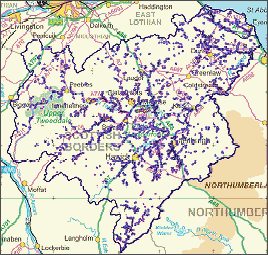Summary
 Background
Background
In 1994, Chris Badenoch reported that the ancient semi-natural woodlands of Tweeddale covered 0.06% of the land area, “…a figure which compares closely to that of Caithness, surely the bleakest place in Scotland…”.
Although 18% of the land area of the Scottish Borders is covered by plantation woodland, the regional local biodiversity action plan (LBAP) woodland working group were conscious of the minute proportion of native woodland (estimated at 1355 ha – 0.3% of the land area).
This pilot study, undertaken to demonstrate the impact of the Scottish Forestry Grant Scheme rules and provide an initial exploration of focal species modelling, was completed in 2003.
The initial work on the development of a forest habitat network (FHN) for the Scottish Borders was tied closely to the rules of the Scottish Forestry Grants Scheme (SFGS). In mimicking the rules of the SFGS, the main aims of the project were to assess the contribution, spatial extent and type of native woodland expansion that could occur, and what it’s impact might be on the existing Borders landscape.
Objectives
- Develop a practical method to identify key areas for the restoration and expansion of native woodlands that link framework woodlands (both native and non-native on ancient woodland sites)
- Develop a methodology to assess the contribution of forest habitat networks (FHNs) for conserving species within the landscape mosaic
- Examine the effect of native woodland expansion on the landscape character of selected catchments.
Methods
- Framework native woodland was buffered to 300 m and the existing land use within assessed for woodland type using Ecological Site Classification.
- The Habitat Network Tool from BEETLE (Biological and Environmental Evaluation Tools for Landscape Ecology) was used to assess the functional connectivity within FHNs.
- The effect of woodland expansion on habitat network size and position was assessed.
- BEETLE was used to assess where broadleaved woodland habitat networks, well suited to grey squirrels dispersal, may fragment red squirrel reserves in coniferous woodland core areas in the Ettrick catchment, and the impact on open-habit networks, for example used by the large heath butterfly.
Results summary
- Only small remnant ancient semi-natural woodlands remain in the Scottish Borders, only 608 ha of ancient semi-natural woodland (0.13% of the land area).
- Categories of ancient, long established and semi-natural woodland and the semi-natural and high native component classes of the Scottish Semi-Natural Woodland Inventory (SSNWI) comprised 5220 ha (1.4% of the land area). Planted Ancient Woodland Sites (PAWS) account for 1355 ha (0.3% of the land area).
- The study indicated that the SFGS could deliver a significant amount of the wet woodland habitat action plan (HAP) target, the upland oak woodland HAP target and the Juniper species action plan (SAP) target in the Scottish Borders.Native woodland habitat network development in the Scottish Borders should take care to maintain barriers to grey squirrel incursions around red squirrel reserves. This work has been expanded to assess and identify woodland reserves suitable for red squirrel conservation.
- FHNs in the Scottish Borders lie in the arterial valleys close to existing native woodland, often riparian in character. To a lesser extent there could be expansion in steep sided upland valley, adjacent to cleuch woodland remnants.
- The effect of the native woodland expansion policy has the potential to complement and soften rigid, hard-edged woodland blocks within several landscape character types, and improve the aesthetic appeal of many Scottish Border landscape types.
General Content
What’s of interest
Native Woodland Habitat Networks in the Scottish Borders Study Report (PDF-322K)
This research was funded by:
Forestry Commission (Scotland)
Scottish Natural Heritage
Scottish Borders Council
